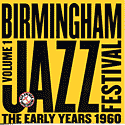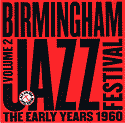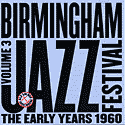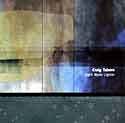| |


I N - T H I S - I S S U E :
 



Index of
SEMJA reviews
|
|
Recent Recordings by Area Musicians
BY PIOTR MICHALOWSKI
Dave
Usher has been making jazz recordings in Detroit for decades, and is remembered
by many for his Dee Gee label that he ran together with Dizzy Gillespie
in the fifties and for his work as a producer for Argo in Chicago. Since
those days he has moved on to successes on other arenas, but he still
releases interesting recordings now and then. SEMJA reviewed the marvelous
CDs he put out a few years ago from Gillespie's 1956 South American
big band tour. This time we feature his three volumes of music from the
first Birmingham Jazz Festival that took place in 1960 (Birmingham
Jazz Festival, The Early Years, 1960 [CAP 920-22, Red
Anchor Productions]).
These forty-year-old recordings, which are surfacing
for the first time, are a joy to hear. The players were mainly Detroit
based, with a few unusual guests. The first CD features the rhythm section of drummer J. C. Heard, pianists Junior Mance, and bassist
Nick Fiore, who at the time was working with pianist Bess Bonnier. On
the first three cuts the front man is tenor saxophonist Sandy Mosse, a
Stan Getz/Al Cohn disciple who was a major player on the Chicago scene
at the time. Mosse was born in the Motor City, but he left at the age
of eleven and grew up on the north side of Chicago together with other
musicians such as Lou Levy. He spent some time playing in France and after
his return led his first recording session for Argo, Relaxin' with Sandy
Mosse, accompanied on some tunes by none other than Junior Mance (his
early recordings with Zoot Sims and Henri Renaud have just been reissued
in the Jazz in Paris series). Before coming to Birmingham the tenorist
had taken part in sessions with other Argo artists, among them James Moody
and Cy Touff. At the festival he demonstrated his strong sense of swing
and his allegiance to the Lester Young school filtered through the "Four
Brothers" mode. From the first notes of an up-tempo rendition of
"Frankie and Johnny" we know that we are in Pres-mode swing!
One will not find any complex arrangements here, only first rate festival
style jamming, complete with solos from all members of the band and the
requisite trading of fours with the drummer. Heard is the perfect accompanist
here, as his transitional swing-to-bop style matches the way in which
Mosse handles rhythm. After slowing down for a soulful version of "Sweet
and Lovely," the quartet ends with a Latin-tinged rendition of "That
Old Black Magic" on which Mosse sounds very much like Zoot Sims.
rhythm section of drummer J. C. Heard, pianists Junior Mance, and bassist
Nick Fiore, who at the time was working with pianist Bess Bonnier. On
the first three cuts the front man is tenor saxophonist Sandy Mosse, a
Stan Getz/Al Cohn disciple who was a major player on the Chicago scene
at the time. Mosse was born in the Motor City, but he left at the age
of eleven and grew up on the north side of Chicago together with other
musicians such as Lou Levy. He spent some time playing in France and after
his return led his first recording session for Argo, Relaxin' with Sandy
Mosse, accompanied on some tunes by none other than Junior Mance (his
early recordings with Zoot Sims and Henri Renaud have just been reissued
in the Jazz in Paris series). Before coming to Birmingham the tenorist
had taken part in sessions with other Argo artists, among them James Moody
and Cy Touff. At the festival he demonstrated his strong sense of swing
and his allegiance to the Lester Young school filtered through the "Four
Brothers" mode. From the first notes of an up-tempo rendition of
"Frankie and Johnny" we know that we are in Pres-mode swing!
One will not find any complex arrangements here, only first rate festival
style jamming, complete with solos from all members of the band and the
requisite trading of fours with the drummer. Heard is the perfect accompanist
here, as his transitional swing-to-bop style matches the way in which
Mosse handles rhythm. After slowing down for a soulful version of "Sweet
and Lovely," the quartet ends with a Latin-tinged rendition of "That
Old Black Magic" on which Mosse sounds very much like Zoot Sims.
The rest of the first CD is taken up by the three
musicians without Mosse. Pianist Mance was beginning to make a name for
himself at this time, having just spent some time with Dizzy Gillespie
and his first trio album was already out. He is still playing well today;
when these recordings were made his style was already set and has not
changed very much since. Mance is a swinger who likes to lay on the funk
and find the blues wherever he can, as demonstrated well in his feature
on "Willow Weep for Me." The same trio, now under the nominal
leadership of J. C. Heard, offers three more romping, blues inflected
numbers.
Volume two opens with three tracks with the same trio
in support of vibraphonist Lem Winchester. Winchester had a very short
career that was cut short by a deadly accident less than a year  after
this performance and he left only a small but distinguished recorded legacy.
Here he immediately finds common ground with his companions and shows
off his Bags- inspired, blues-drenched style on his idol's "Bluesology;"
he and Mance are particularly well matched, and one can only wonder if
there is more material by this quartet in Usher's collection. After the
visitors, it is time for Detroit pianists to show their stuff. Bess Bonnier
and her trio (bassist Fiore and drummer Dick Riordan) offers a smooth,
laid-back, classical bop rendition of "Back Home in Indiana,"
followed by a number that is primarily a feature for the drummer. The
late Johnny Griffith gets to play only one number, Bud Powell's lovely
"Celia." Detroiters do not need to be reminded of Griffith's
consummate bop chops, but those who know him mainly from his days at Motown—he
played on such hits as "I Heard it Through the Grapevine"—will
be pleasantly surprised by his playing on this track. Again, one begs
for more! after
this performance and he left only a small but distinguished recorded legacy.
Here he immediately finds common ground with his companions and shows
off his Bags- inspired, blues-drenched style on his idol's "Bluesology;"
he and Mance are particularly well matched, and one can only wonder if
there is more material by this quartet in Usher's collection. After the
visitors, it is time for Detroit pianists to show their stuff. Bess Bonnier
and her trio (bassist Fiore and drummer Dick Riordan) offers a smooth,
laid-back, classical bop rendition of "Back Home in Indiana,"
followed by a number that is primarily a feature for the drummer. The
late Johnny Griffith gets to play only one number, Bud Powell's lovely
"Celia." Detroiters do not need to be reminded of Griffith's
consummate bop chops, but those who know him mainly from his days at Motown—he
played on such hits as "I Heard it Through the Grapevine"—will
be pleasantly surprised by his playing on this track. Again, one begs
for more!
The next visitor at the festival was violinist Joe
Kennedy Jr. Not as well known perhaps as some of the others, he has been
appreciated over the years by lovers of the jazz violin. At the time of
this performance he had come to some attention because of his work as
arranger and violinist with the then very popular pianist Ahmad Jamal.
Here he shows why he is considered by many to be one of the finest jazz
players on his instrument. His passionate swinging, improvising combines
many of the elements found in the styles of Eddie South and Stuff Smith
with the harmonies of modern jazz, and unlike many classical violinists,
his phrasing is perfectly idiomatic. Kennedy is still playing strong and
is scheduled to appear at the Jewish Community Center in Oak Park on Feb.21
at 2 p.m. and at Rackham Auditorium in Detroit on Feb.23 at 7 p.m.
The final guest, who opens volume three, is the well-known
guitarist and harmonica  player
Toots Thielemans, who is joined once again by the house trio of Mance
and Co. In 1960 Thielemans had just left the highly successful George
Shearing Quintet and was striking out on his own; mercifully he had not
yet composed "Bluesette," and so his set consists of some well-known
standards and an original blues. "I'll Remember April" features
his harmonica, but after that he moves on to the guitar and clearly thrills
the audience with a playful "The Blues and I" that makes one
think he was born on the south side of Chicago and not in Belgium. After
showing off his patented guitar and whistling act, Thielemans calls the
whole gang to the stage for a long workout on rhythm changes, and then
the festival ends with a round of applause for producer Dave Usher. player
Toots Thielemans, who is joined once again by the house trio of Mance
and Co. In 1960 Thielemans had just left the highly successful George
Shearing Quintet and was striking out on his own; mercifully he had not
yet composed "Bluesette," and so his set consists of some well-known
standards and an original blues. "I'll Remember April" features
his harmonica, but after that he moves on to the guitar and clearly thrills
the audience with a playful "The Blues and I" that makes one
think he was born on the south side of Chicago and not in Belgium. After
showing off his patented guitar and whistling act, Thielemans calls the
whole gang to the stage for a long workout on rhythm changes, and then
the festival ends with a round of applause for producer Dave Usher.
One can only follow in the footsteps of those who
were there and add our thanks to Usher for organizing the festival and
for offering these recordings to the larger public after all these years.
Rather than bring the well-known stars to Birmingham, Usher organized
the festival around musicians with whom he had a personal relationship.
Many of them came from Detroit and Chicago, his two hometowns, and most
of them had been recorded by Argo, including Mosse, Bonnier, Winchester,
Kennedy, and Heard. Those disks are long out of print and one can only
hope that they will be reissued soon. But for swinging, joyous festival
fare get these three CD's. If you can only get one, my one personal
preference would be for volume two because I have a decided preference
for the playing of Winchester and Kennedy.
Pianist
Craig Taborn left the area a few years ago, but many here still
follow his musical progress. Most recently he has been gigging and recording
with Mat Maneri  and
Tim Berne, mainly sticking to the electronic keyboards. His Ann Arbor
performance with Berne's trio this fall was one of the high points of
this year's Edgefest according to many. His latest trio finds him returning
to the acoustic piano in a trio with bassist Chris Lightcap and recent
ex-Detroiter Gerald Cleaver on drums (Light Made Lighter
[Thirsty Ear THI 57112]). I can
only comment on this CD briefly here, but if I had to find a quick characterization
for it, I would say that it is the most beautiful recording that Taborn
has made to date. He composed all the songs with the exception of the
1933 ballad "I Cover the Waterfront," which he restates as a
hot modern piece. On the fast numbers his rapid, quirky off-center runs
find perfect echoes and answers from Cleaver's drums, and on the slow
pieces his trio mates work around him with discretion. There is a wide
variety of tempos and moods here, but even the faster numbers have a pensive
quality, but it is the ballads that stay in mind the most after the disk
falls silent. Taborn has found an unsentimental beauty that is pianistic
without resorting to clichéd voicings and arpeggios, avoiding the
Jarrettisms that are so common these days. The music is sometimes almost
austerely classical at times, with an atmosphere that sometimes reminds
one of Charles Ives, but never imitates anyone. This is a haunting recital
that attracts the ear again and again. and
Tim Berne, mainly sticking to the electronic keyboards. His Ann Arbor
performance with Berne's trio this fall was one of the high points of
this year's Edgefest according to many. His latest trio finds him returning
to the acoustic piano in a trio with bassist Chris Lightcap and recent
ex-Detroiter Gerald Cleaver on drums (Light Made Lighter
[Thirsty Ear THI 57112]). I can
only comment on this CD briefly here, but if I had to find a quick characterization
for it, I would say that it is the most beautiful recording that Taborn
has made to date. He composed all the songs with the exception of the
1933 ballad "I Cover the Waterfront," which he restates as a
hot modern piece. On the fast numbers his rapid, quirky off-center runs
find perfect echoes and answers from Cleaver's drums, and on the slow
pieces his trio mates work around him with discretion. There is a wide
variety of tempos and moods here, but even the faster numbers have a pensive
quality, but it is the ballads that stay in mind the most after the disk
falls silent. Taborn has found an unsentimental beauty that is pianistic
without resorting to clichéd voicings and arpeggios, avoiding the
Jarrettisms that are so common these days. The music is sometimes almost
austerely classical at times, with an atmosphere that sometimes reminds
one of Charles Ives, but never imitates anyone. This is a haunting recital
that attracts the ear again and again.
I N - T H I S - I S S U E :
1. RECENT
RECORDINGS BY AREA MUSICIANS---
2. KEVIN MAHOGANY---3. D.D.
JACKSON
HOME
|
|

